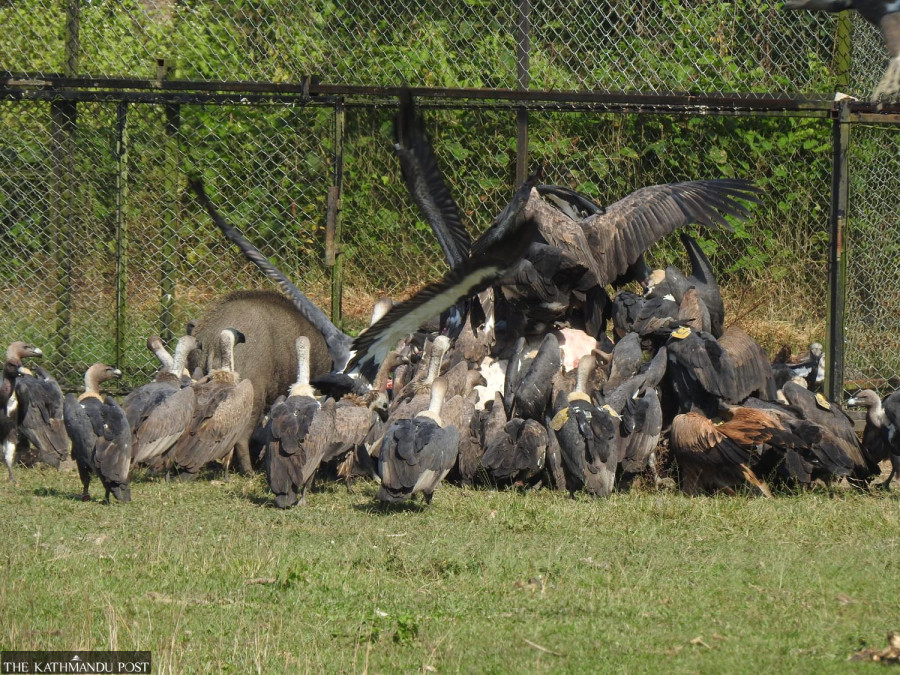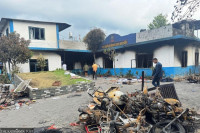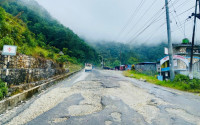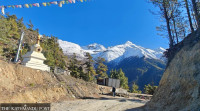Gandaki Province
Ten vultures from Kasara breeding centre released into the wild
As many as 69 vultures have been freed from the centre since it was set up in 2008.
Narayan Sharma
As many as 10 vultures that were bred and raised in Chitwan National Park’s breeding centre were released in the wild on Saturday. A team of conservationists released the birds of prey in the Pithauli forest area near a vulture restaurant—an artificial feeding site—in Kawasoti of East Nawalparasi district.
DB Chaudhary, a conservationist who has been working for years in vulture conservation, said the freed birds have been fitted with tag numbers and GPS trackers. “We did that so we can easily track and monitor them,” Chaudhary said.
The vultures that were freed on Saturday are of the critically endangered white-rumped species, colloquially known as dangar gidda. White-rumped vultures are the smallest among the nine vulture species found in Nepal.
Nepal has recorded nine of the 23 vulture species found in the world so far. Four of them—white-rumped vulture, slender-billed vulture, red-headed vulture and Indian vulture—are listed as critically endangered by the IUCN. The Egyptian vulture is listed as endangered and three species—bearded vulture, cinereous vulture and Himalayan griffon—are listed as near threatened.
The scavengers were released in Namuna Buffer Zone Community Forest, where the vulture restaurant was established in 2006 to conserve them. The restaurant manages carrions and water for the scavengers.

The vulture population is on the rise in the Pithauli area lately. A good number of vultures visit the restaurant to eat carrions. In a rare and encouraging incident, as many as 465 vultures, including some critically endangered species, were sighted in the vulture restaurant at the same time on February 2. “The vulture restaurant set up in Pithauli with the participation of local people has helped in increasing the number of vultures,” said Haribhadra Acharya, the chief conservation officer of Chitwan National Park. “The conservation effort is quite effective and sustainable.”
The vulture population, mainly that of the white-rumped vultures, dwindled in Nepal sharply, as it did in the whole of South Asia, during the 1990s due to diclofenac poisoning. In Nepal, the population of the white-rumped vulture declined by 91 percent and slender-billed vulture by 96 percent between 1995 and 2011.
Various studies show that the anti-inflammatory drug used to treat livestock found its way into the body of vultures that feed on carcasses and resulted in their kidney failure. The poisoning emerged as a major cause of death of the endangered species.
Various governmental and non-governmental organisations have launched several programmes to conserve vultures in the country. The Kasara vulture breeding centre was established in 2008. So far, as many as 69 vultures that were bred in the centre have been released in the wild.
Similarly, vulture restaurants were set up in several places where the birds could feed on safe carrions. Conservation efforts, including the government decision to ban the production, sale and use of diclofenac in 2006, helped to increase the population of vultures in Nepal, conservationists say.
The Chitwan National Park forests and community forests in the buffer zone in East Nawalparasi and Chitwan districts are the major habitats of vultures lately. “The vulture population is increasing in the area due to safe and suitable habitats,” Chaudhary said.




 16.12°C Kathmandu
16.12°C Kathmandu.jpg)










